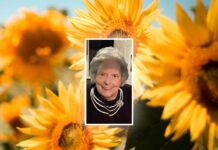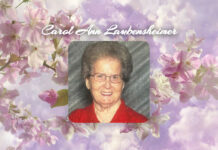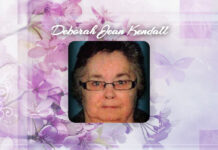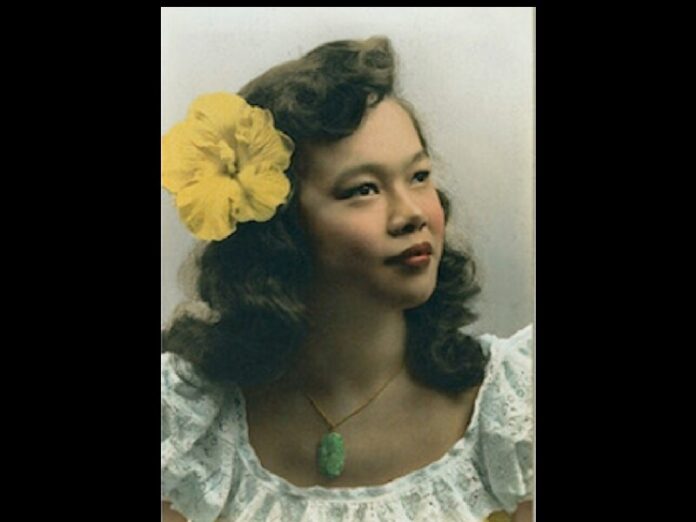Rejected by her family for marrying a “haole,” then moving thousands of miles away from her home in Hawaii with her new husband, Dr. Hal Hooper, to once again be rejected by his culture in Tennessee was a daunting beginning to Betty Hopper’s married life. Not to mention meeting during a time of war. However, between his perseverance and her quiet grace, in the end they proved that love wins.
Born in Hawaii
Born on June 21, 2025 as Hu Sin Hee in Honolulu to Que Lin Yuen (Rose) Hee and Kwai Yin Hat, Betty Hooper was the fifth of eight children of second-generation immigrants from Canton, China. She and her siblings grew up mostly on the island of Oahu, though the family spent a year on the island of Maui, and another on the island of Molokai. She and her siblings spent a lot of time outdoors, learning to swim at some of the most breathtaking beaches in the world, hiking verdant valleys, and partaking liberally of the local sugar cane and fruits from the family mango and papaya trees.
Educated at Sacred Heart Academy in Honolulu, Hu Sin converted to Catholicism and took the baptismal name of Betty. She later made the name legal. Her siblings chose the names Bung V. or “Bang,” the oldest, Francis, Lily, Dora, Aurora, Rosie, and Willie.
“My Betty was the quiet one,” wrote Hal in his story of their meeting called, “The Twain did Meet.”. [She had] black, shoulder length hair with a slight curl,… [d]eep, searching eyes, full lips, and a slightly receding chin compliment[ing] her small size. From our first encounter, my inclination was to protect her. “
Experiencing the Day That Lives in Infamy
Betty and her siblings grew up in a rapidly changing Hawaii, not yet a state, but it had been a United States Territory for decades. She witnessed the buildup of naval and air forces at nearby Pearl Harbor and Hickam Field, offering a sense of the importance that Hawaii held in the defense of the United States. With the presence of the Pacific Fleet, and major US air assets at the air force base in Honolulu, inhabitants of the island paradise were lulled into believing they were safe from attack as World War II had raged around them beginning in 1939.
“It was another sunny, breezy, lazy Sunday [on December 7,] 1941, as [my mother] thumbed through the comics of the local paper, when she noticed the low constant drone of distant aircraft,” said her son, H. Wayne Hooper. “Taking it at first for American fighters on maneuvers over nearby Kaneohe, she was little concerned, but as the buzz loudened and broadened [from] scores of planes approaching the island from the north, she sensed something awry. She put down the paper, and walked out into the front yard, looking up and to the west to see dozens of fighters darkening the sky, and worse, smoke billowing from the naval base at Pearl Harbor. Some of the fighters flew close enough overhead for her to see the unmistakable “red sun” markings that she knew could only be Japanese fighters. Betty and her family understood the implications immediately and soon heard from her older brothers, one of whom worked at Pearl Harbor, and the other who was on the base at Hickam Field, that Pearl Harbor and the United States were under attack from Japan.”
Following the attack, Betty lived in daily fear that another attack was imminent. Schools were closed for over a month following the bombing, citizens were handed out and expected to carry gas masks, a curfew was placed in effect from sundown to sunup, and a lights-out policy was enforced, exactly as it was in London.
Spurred to Serve the War Effort

In late 1942, Betty and her sister heard of a civilian group that was being organized across the United States to assist Army Operation centers, thereby freeing up soldiers for battle. Called the WARDs, which stood for Women Air Raid Defense, these women, almost all [of them in their twenties,] mostly college trained and single, were chosen to handle radar readings from various radar positions on the islands as well as the mainland, to interpret them, and then to plot the positions of the planes that had been located on a room-sized map of the surrounding region. Although Betty was only eighteen, she applied, was allowed to take the required tests, and was admitted to the WARDs. She trained for several months and began working at Ft. Shafter in the Army’s 7th Fighter Wing operations center in March of 1943. She was the youngest member of the WARDs, working for them through the end of the war.
Betty continued working with the military, becoming involved with recruiting civilian workers who were dispatched to the South Pacific atolls where work on the hydrogen bomb was being conducted. It was during this time that her sister, Aurora, introduced her to Hal Hooper, a young navy ensign from Waverly, Tennessee who was stationed in Honolulu with the information department. Despite nearing the end of his tour, he became enamored with Betty, and she said that they saw each other almost every day until his departure.
Touring the Mainland and Reconnecting with Hal
In 1949, Betty and her sisters decided to take a cross country tour of the mainland of the United States. Hal met them in Nashville and spent several days with Betty. He then decided he would drive his old ’37 Plymouth to Chicago several weeks later to meet up with Betty again as their tour proceeded West. He proposed to her there, and agreed to return to Hawaii if she would marry him. On returning home, he sold the car and borrowed additional cash for a total of $250. He arrived in Honolulu in the late fall of 1949 with $125 dollars to his name, and he and Betty were married in the Catholic church in Honolulu on November 11, 1949.

“We had a dinner and reception at Lau Yee Chai’s Chinese Restaurant following the wedding, and most of her family [came with] husbands and wives and children…but not her parents,” Hal wrote.
“Similarly, Dad wrote his mother in Waverly…to tell her of his intention to marry Betty,” said Wayne. “He says that she penned a terse response, ‘East is East, and West is West, and never the ’twain shall meet.’ It was a slow thaw on the part of Dad’s family. Mom…said that she wasn’t really shunned. She was met as more of a novelty by most, and only reviled if she was confused as being Japanese, whom she hated for most of her adult life, after Pearl Harbor.”
Her own parents only came around after much work on the couple’s behalf by her siblings, which led to a dinner where Hal hoped to let them know how he felt about their daughter.
Working to Bring Together East and West
“Although I had never seen or spoken to either of them, and could understand none of their Chinese dialect, my heart raced and my breathing became more rapid and shallow as [our] footsteps sounded ever closer to the small porch and front door [of their home],” explained Hal. “Their voices were animated and happy sounding, moods and emotions being easily transmitted in spite of the language barrier. This was the opportunity…I had sought and planned for. It was my one chance to establish a relationship with my wife’s Chinese parents. If I failed tonight, I was positive then, and still am to this day some forty-three years later, that my future children would never know their grandparents and my wife would never see her parents again. I knew that she loved them, and I knew, in my heart, that they had to love her. Yet [we] had had absolutely no contact in over two years, although they lived only a few blocks from [us].”
In a few months, Hal and Betty would be leaving Hawaii to move to Tennessee where Hal had been accepted into medical school. He had delayed his entrance to medical school from April to July 1950, but he could not postpone it further without jeopardizing his acceptance. This was their last chance.
“When Kwai Yin and Rose Yuen Hee opened their…front door and [we] walked inside, their animated conversation came to an abrupt halt,” noted Hal. “They froze in position…There was no greeting for their daughter or this Haole stranger, though the recognition of their daughter and realization of [my] identity…was obvious.”
Hal talked fifteen minutes straight about his love for Betty, only to be met with stone silence, as Betty’s parents carefully maneuvered them back to the front door, pressuring them to leave with a humble demeanor and without saying a word.
They left, heartbroken.
There was no communication from Betty’s parents for three days. Hal assumed that he had failed– until his in-laws invited the couple to come to a family dinner the following Sunday. They were overjoyed. Tears freely flowed. [Hal and Betty] were treated to a nine-course Chinese meal. Hal ate until he could eat no more, and then Mrs. Hee insisted that they take the leftovers home.
“We were greeted that day as if there had never been a schism in the family,” added Hal with awe. “There was no mention of the previous Sunday’s events or of the previous two years. It was as if they didn’t happen… East is east, and west is west, and the twain did meet!”
Happily Ever After

The couple would enjoy many more happy times with Betty’s parents before departing for Memphis, where Hal completed medical school. And they would visit with them many more times until their deaths.
After completing medical school, Hal and Betty moved initially to Madisonville, Tennessee, with, by that time, three daughters and one son in tow, and then to Sweeney, Texas, with an additional boy in the mix, and several years later, on to Dickson, Tennessee, where their sixth child…was born. Finally, in late 1962, Betty and Hal made their final move to Gallatin, Tennessee, where they, mostly Betty, designed and built their permanent home and raised their burgeoning family.
Betty also turned herself into an active gardener and wildflower expert. She was a founding member of the local wildflower group and traveled the hills and hollers of Tennessee exploring the local flora, incorporating many indigenous plants into her garden. In her spare time, she became a skilled painter and excelled in other handicrafts as well.
“My mother is a quiet…sweet and gentle woman,” said Wayne. “Growing up, she was the one stirring the pots and serving the refreshments in the background. She abhors attention. She sees the humor in others, but still doesn’t share easily. She made my siblings and I who we are, teaching us both Eastern and Western culture. I owe so much to that woman.”
Subscribe to our Newsletter!


























